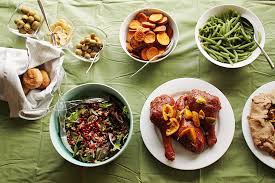The sugary, fatty carb-induced coma most Americans seem to find ourselves in post-Thanksgiving dinner is enough to make any dietician cringe. Allison Riederer — Assistant Professor of Nutrition and Integrative Physiology at the College of Health — has some suggestions to stay relatively sane and keep gluttony in check while enjoying a traditional feast.
Some of the most popular Thanksgiving staples can be made from scratch. Riederer suggests implementing semi-homemade versions instead of a canned ones, especially if you have been tasked with cooking. Buying a can of cranberry sauce instead of making it yourself will get you “fewer good things” like vitamins and fiber, according to Riederer. The saving grace for cranberry sauce is the “base of whole fruit” and she explained canned cranberry is basically like getting cranberry flavored gelatin.
For other recipes, such as green bean casserole, using a canned ingredient for the dish can be a good thing. It saves time and energy — just opt in for “low sodium” when purchasing the soup. “I would just use cream of mushroom soup, yes it’s going to be higher in salt. It’s a matter of what you have time for, what you have mental threshold for” Riederer said. Boxed foods such as stuffing can be upped in nutrition by adding some fresh vegetables, like onions and celery. “So, this idea of making everything from scratch is great but it’s not necessarily realistic for everybody or for many people,” Riederer said. Making food healthier for one day shouldn’t necessarily be the goal either, but Riederer has a different take.
“I strongly encourage what we call the plate method,” Riederer said, which consists of half veggies, a quarter protein and a quarter carbs. Keeping this in mind while you pile things onto your plate will help you not overindulge. This rule applies not only to Thanksgiving but every day. Her philosophy is “eat what you love, enjoy it.” For example, Reiderer explained if you are only going to eat few carbs and your mouth has been watering for mashed potatoes, put that on your plate instead of a roll. During her own Thanksgiving meal at home Riederer said: “I just look for the foods I like the best.” The idea of intuitive eating is something Riederer is a proponent of. “I eat exactly what I want but I’ve worked really hard at stopping when I’m full and that is something that is a challenge on Thanksgiving,” Riederer said.
During this time of year, filled with feasts and festivities, Riederer recommends counteracting all of this by “doing something active every day.” After the meal is done maybe take a small walk, instead of the nap the tryptophan in the turkey is begging you to take. As the holiday season continues Riederer said to ask yourself every day, “what’s a healthy choice you can make?” For some, simple hydration is enough, especially once the alcohol comes out. “I’m going to have a glass of water and then I’m going to have a drink, I’m going to have a glass of water then I’m going to have a drink, and just staying hydrated,” Riederer said.
Emotional health is just as important as physical health during holiday stress. “So many of us, in our culture, eat emotionally,” Riederer said. Check yourself — notice if you are eating because you’re hungry or because your mom is being too critical again. This goes for alcohol too.
In the end, the tradition of Thanksgiving for most of us boils down to family and friends and enjoying a meal with one another. Staying mindful of what you put in your mouth that day, and all the other days of the year, and being aware of when your body is full is important for balance. Have a Happy Thanksgiving and remember to have a slice of pumpkin pie.
h.vasic@dailyutahchronicle.com


